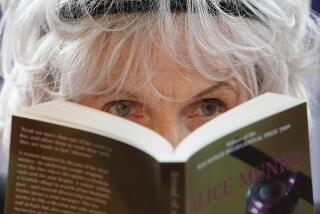Prisons of the Mind : WHAT KEEPS ME HERE.<i> By Rebecca Brown (HarperCollins: $20, 136 pp.)</i>
- Share via
She is bound to a wooden chair. Boards press against her ears, and a belt covers her eyes. The woman can’t hear, see or move, but she can speak. As the protagonist in the last story of Rebecca Brown’s new short story collection, “What Keeps Me Here,” the woman tells the story of her bondage--and she experiences literally what the other female characters have endured figuratively in the previous nine stories.
In this intense and engaging work, Brown creates a world populated primarily by women. The structure of this collection resembles her last, the award-winning “Gifts of the Body,” where the stories are linked by theme. Together, they invalidate the rhetoric and prejudice that stigmatize people with AIDS.
By contrast, “What Keeps Me Here” investigates the female psyche. These stories dramatize the ways in which society entraps women and how the resulting prisons make indelible marks on their minds. Brown illustrates the power dynamics in both heterosexual and homosexual relationships, and she portrays the consequences of psychic and sexual abuse. Her characters often feel punished and ashamed. They are conflicted, struggling against the desire to remain in a harmful situation only because it is familiar.
In “A Relationship,” a lesbian can’t stop loving her former lover, who is now with a man. The former lover can’t decide if she wants to stay with him and she claims to be in danger. But when the protagonist tries to rescue her, the former lover pretends nothing is wrong. This triangle inflicts pain on all of them. “What I don’t know,” the main character says, “is why I stay.”
In “An Enchantment,” a woman remains with her female lover, who beats and rapes her. The lover is an empress who sports a belt of scalps. She also is hollow. The setting of the story is both medieval and modern: The empress locks the protagonist in a castle, equipped with TV and bonbons, and the main character grows accustomed to the violence. “I became the thing I did,” she says, “the thing that was done unto me.”
In “The Princess and the Pea,” Brown tells a different kind of fairy tale. The narrator’s girlfriend refuses to make love because she believes that something is in their bed. The woman disassembles the bed and examines each part, hoping to find the “something” that is driving her lover away. But it’s not an object--it is her lover’s shame. She begins to recall an incident of sexual molestation and doesn’t want to be held or touched. She believes there is a mark on her back. But the scar is really inside her mind.
Brown’s work should be read slowly. Her stories are complex puzzles that hold images of the way we function in modern life, and the dramatic situations in most of her narratives represent psychological dynamics. “What Keeps Me Here” evokes the surrealism of Franz Kafka and the gender ambiguity of Jeanette Winterson.
But Brown has her own style. Some of her stories are gothic, others are parables. All of them have an archetypal quality. Underneath her spare and exact prose is a haunting, age-old subtext: Our environments shape us. Yet her message has a contemporary twist: These societal prisons are reconstructed in our minds.
Her characters, however, hope that they will break free. First, they must expose the prisons, and “What Keeps Me Here” does exactly that in ways both stark and subtle. This collection is a compelling map of the intricate workings of our minds.
More to Read
Sign up for our Book Club newsletter
Get the latest news, events and more from the Los Angeles Times Book Club, and help us get L.A. reading and talking.
You may occasionally receive promotional content from the Los Angeles Times.










